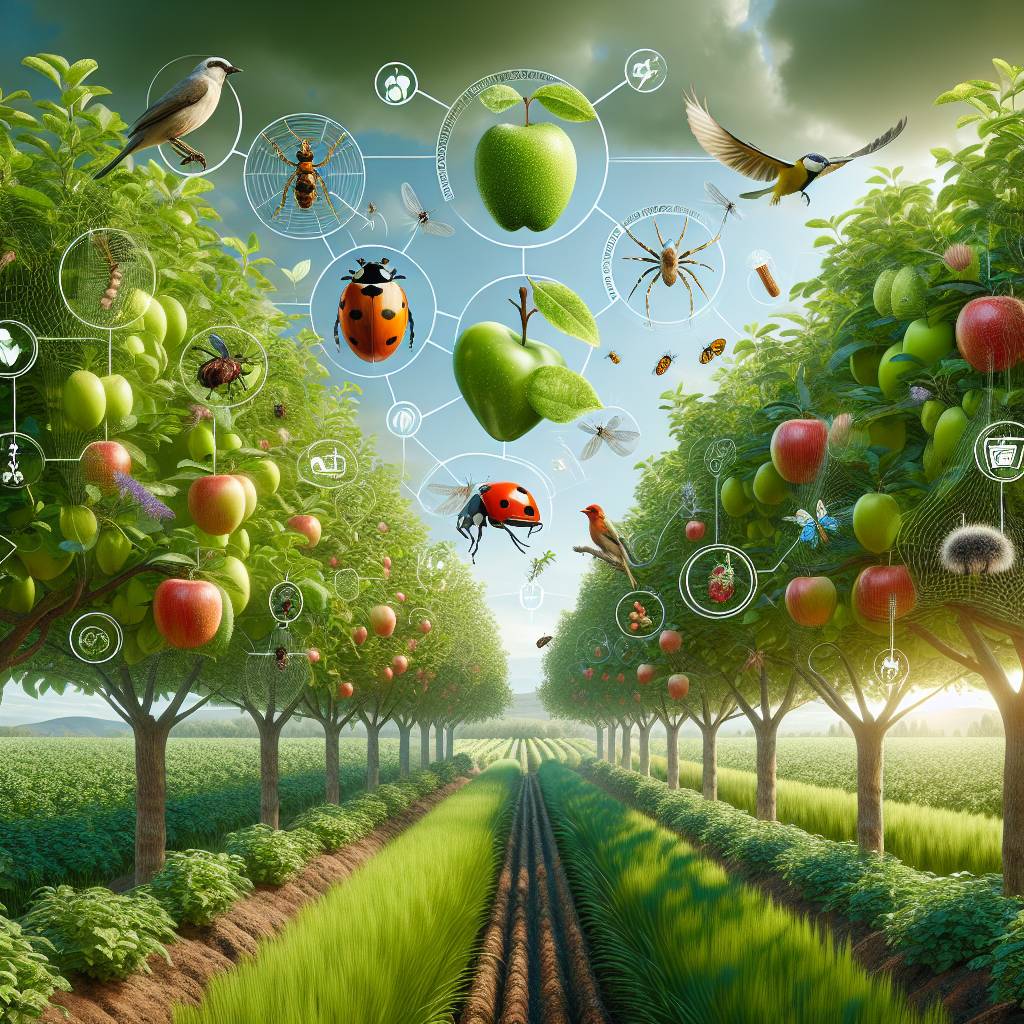Traditional methods often involve harsh chemicals that can harm the environment and beneficial insects. Organic Pest Control. However, there’s a better way. Eco-friendly pest control for fruit trees offers a stark contrast, providing effective solutions while minimizing the impact on the ecosystem.
Key Takeaways
- Encourage natural predators like ladybugs and lacewings to control pest populations in your fruit trees.
- Implement holistic approaches such as maintaining soil health and proper pruning to promote overall fruit tree health and resilience against pests.
- Identify and manage overwintering pests by cleaning up debris, using dormant oils, and applying beneficial nematodes.
- Protect fruit trees from rabbits and rodents naturally by installing physical barriers and using repellents like garlic and pepper spray.
- Manage aphids on fruit trees organically by introducing beneficial insects, spraying with neem oil, or using a strong blast of water to dislodge them.
- Choose disease-resistant fruit tree varieties to reduce the need for chemical treatments and promote a healthier orchard ecosystem.
- Conduct regular inspections of your fruit trees to detect pest infestations early and take appropriate action to prevent widespread damage.
- Apply holistic sprays like horticultural oil and insecticidal soap at the optimal timing to effectively manage pest populations without harming beneficial insects.
- Explore alternative natural methods such as pheromone traps, companion planting, and reflective mulches to protect your fruit trees in an eco-friendly manner.
Encouraging Natural Predators for Pest Management
Introducing Beneficial Insects
Introducing beneficial insects like ladybugs and lacewings is a natural and effective way to control pests on fruit trees. Ladybugs, also known as lady beetles or ladybird beetles, are voracious eaters of aphids, mites, and other small insects that can damage fruit trees. Lacewings, with their delicate appearance, are fierce predators of aphids and other soft-bodied pests. By introducing these beneficial insects and product into your garden, you can reduce the need for chemical pesticides while promoting a healthy environment for your fruit trees.
These beneficial insects act as natural predators, targeting harmful pests without causing any harm to the fruit trees themselves. They offer an eco-friendly product solution to pest control by maintaining a balance in the ecosystem. For example: Instead of using chemical sprays to combat aphid infestations on apple trees, releasing ladybugs can effectively manage the pest population without harming the tree or contaminating the fruits.
Attracting Birds for Pest Control
Attracting birds to your garden provides another layer of natural pest management for fruit trees. Many bird species feed on insects that can cause damage to fruit crops. By creating an inviting environment with bird feeders, birdbaths, and suitable nesting sites within or near your orchard area, you encourage birds to visit regularly and help keep pest populations in check naturally.
Birds such as chickadees, nuthatches, warblers, and wrens are known for consuming caterpillars and insect larvae that pose threats to fruit tree health. Their presence not only aids in controlling pests but also adds beauty and liveliness to your garden space. For instance: Setting up birdhouses around your orchard area can attract bluebirds that will actively hunt down caterpillars damaging peach or cherry blossoms.
Creating a Diverse Habitat with Native Plants
Creating a diverse habitat within your garden by incorporating native plants provides essential resources for a variety of natural predators crucial in managing pest populations effectively. Native plants attract diverse wildlife including predatory insects like ground beetles which prey on soil-dwelling pests such as slugs and snails.
Holistic Approaches to Fruit Tree Health
Compost and Organic Fertilizers
Fruit trees benefit from compost and organic fertilizers, promoting overall tree health. These natural solutions provide essential nutrients for the tree’s growth without harmful chemicals. For example, compost enriches the soil with beneficial microorganisms that support the tree’s immune system, making it more resilient against pests and diseases. By using these eco-friendly methods, fruit trees can thrive in a sustainable manner while minimizing negative impacts on the environment.
Mulch around the base of fruit trees is another important practice in maintaining their health. Mulching helps conserve moisture in the soil, reducing water consumption while also suppressing weed growth. This method not only supports eco-friendly pest control but also contributes to a healthier ecosystem by preserving water resources and preventing unnecessary chemical herbicide use.
Proper Pruning Techniques
Proper pruning techniques play a crucial role in improving air circulation around fruit trees and reducing disease risk. Trimming away dead or diseased branches removes potential breeding grounds for pests and pathogens. Strategic pruning enhances sunlight exposure to all parts of the tree, fostering better fruit development while discouraging pest infestations.
Identifying and Managing Overwintering Pests
Inspecting for Signs of Overwintering Pests
During the winter, it’s crucial to inspect fruit trees for any signs of overwintering pests. Look out for egg masses, webs, or any unusual formations on the branches. These could be indications of potential pest infestations that can harm the trees when spring arrives. By being proactive and identifying these signs early, you can take necessary actions to prevent extensive damage.
Inspecting fruit trees during winter allows you to catch insect pests in their dormant state before they become active again in spring. This method helps control their population effectively without causing harm to the environment or the fruit trees themselves.
Pruning and Removing Infested Branches
Once signs of overwintering pests are spotted, it is essential to act promptly by removing and destroying infested branches. Pruning affected areas before spring prevents the pests from spreading further once warmer weather arrives. By taking this step, you’re not only managing current pest issues but also preventing future infestations by eliminating potential breeding grounds.
Pruning off infested areas also promotes overall tree health by removing diseased portions that might affect growth and yield come springtime. Furthermore, this approach aligns with a holistic perspective on fruit tree health, as discussed in the previous section.
Applying Dormant Oil Spray
To suffocate overwintering pests effectively, applying a dormant oil spray in late winter is highly recommended. This eco-friendly solution coats overwintering insects with oil, blocking their air supply and ultimately leading to their demise without harming beneficial insects or other wildlife.
Dormant oil sprays are particularly effective against various types of scale insects and mites that tend to overwinter on fruit trees’ bark or branches. They serve as an environmentally friendly method for controlling insect pests while minimizing adverse effects on non-target organisms such as birds or bees.
Protecting Trees from Rabbits and Rodents Naturally
Physical Barriers
One effective way to protect fruit trees from rabbits and rodents is by installing physical barriers. This involves placing wire mesh or tree guards around the base of the trees. These barriers act as a deterrent, preventing rabbits and rodents from gnawing on the bark or accessing the soil around the tree.
Planting repellent herbs like lavender or rosemary near fruit trees can also deter rabbits and rodents. The strong scent of these herbs acts as a natural deterrent, keeping pests away from the trees. These herbs can enhance the overall aesthetics of your garden while serving as a protective measure for your fruit trees.
Natural Deterrents
Another way to control pests without harming the environment is by using natural deterrents such as garlic spray or predator urine. Spraying garlic solution around fruit trees creates an unpleasant odor for rabbits and rodents, deterring them from feeding on the branches and leaves. Predator urine, obtained commercially, mimics potential threats to pests’ survival in their natural environment.
In addition to these methods, maintaining proper garden hygiene plays a crucial role in pest control for fruit trees. Clearing fallen leaves, fruits, and other organic debris reduces hiding spots for pests while promoting healthy soil conditions that are less conducive to pest infestations.
To summarize:
- Installing wire mesh or tree guards provides physical protection against rabbit and rodent damage.
- Planting repellent herbs like lavender or rosemary serves as a natural deterrent.
- Using garlic spray or predator urine discourages feeding by unwanted pests.
- Maintaining good garden hygiene reduces hiding spots for pests while fostering healthier soil conditions.
Organic Management of Aphids on Fruit Trees
Suffocating Aphids
A simple and effective method to control aphids on fruit trees is by creating a mixture of water and dish soap. This natural solution can be sprayed directly onto the aphids, suffocating them and preventing further damage to the trees. By using this eco-friendly approach, you avoid harmful chemicals that could potentially affect the environment.
Aphids are small insects that feed on the sap of plants, causing damage to leaves and slowing down the growth of fruit trees. Using a water and dish soap spray not only helps in controlling these pests but also promotes an environmentally friendly way of managing pest infestations.
Introducing Beneficial Insects
Another eco-friendly method for managing aphids on fruit trees involves introducing beneficial insects such as ladybugs or parasitic wasps into your orchard. These natural predators feed on aphids, helping to keep their population in check without harming the environment. This approach creates a balanced ecosystem within your orchard, reducing the need for chemical interventions while effectively controlling pest populations.
By inviting helpful insects like ladybugs or parasitic wasps into your orchard, you create a sustainable solution for managing aphid infestations naturally with organic pest control. This method not only benefits your fruit trees but also supports biodiversity within your garden or orchard.
Pruning Infested Branches
Pruning heavily infested branches from fruit trees is another essential step in eco-friendly pest control management. By removing these affected branches and disposing of them away from the orchard area, you prevent further spread of pests while promoting tree health. This practice reduces the reliance on chemical treatments while maintaining an environmentally conscious approach to pest management.
Pruning heavily infested branches not only removes existing sources of pests, it also enhances air circulation within the tree canopy which contributes to overall tree health.
Disease Resistant Varieties for Healthier Fruit Trees
Choose Wisely
Selecting disease-resistant varieties is crucial. By choosing fruit tree varieties that are naturally resistant to common diseases in your region, you can significantly reduce the need for chemical interventions. For instance, if you’re dealing with citrus trees, consider selecting disease-resistant citrus tree varieties like ‘Meyer’ lemon or ‘Satsuma’ mandarin. These types of trees have a natural ability to fend off diseases such as citrus canker and greening.
Rootstock Protection
Researching disease-resistant rootstocks is another vital aspect of eco-friendly pest control for fruit trees. Certain rootstocks offer added protection against soil-borne pathogens, enhancing the overall health and vigor of the tree while reducing its susceptibility to diseases. When planting new fruit trees or replacing existing ones, look into rootstock options known for their disease resistance qualities.
Choosing appropriate rootstocks based on their resistance to specific diseases prevalent in your area can make a significant difference in preventing infections that may otherwise require chemical treatments.
Practicing good sanitation by removing fallen leaves or fruits from around the base of the tree is essential as well. This simple action helps prevent the spread of various fungal and bacterial diseases often found in decaying organic matter on orchard floors.
Regular Inspections to Prevent Infestations
Vigilant Monitoring
Monitor your fruit trees regularly for signs of insects or diseases. Check the undersides of leaves and inspect fruits for any abnormalities. Pay close attention to the health of your trees, especially during spring when pests are most active.
Regular inspections allow you to catch pest infestations early, preventing widespread damage and reducing the need for harsh chemical treatments. By detecting issues promptly, you can take swift action to protect your fruit trees from harm.
Immediate Action
Take immediate action if you detect any signs of pests or diseases on your fruit trees. Consider using eco-friendly pest control methods such as applying natural predators like ladybugs or lacewings, using sticky traps near affected areas, or introducing beneficial nematodes into the soil.
Consider spraying a mixture of water and mild dish soap onto affected areas as a gentle yet effective way to manage infestations. Pruning infected branches and removing fallen fruits can help prevent further spread of pests and diseases.
Holistic Sprays and Their Optimal Application Timing
Organic Sprays
Using organic sprays like neem oil or insecticidal soap is highly effective. These sprays target pests without harming beneficial insects, making them an ideal choice for maintaining a healthy ecosystem in your garden. By opting for organic solutions, you can effectively manage pest issues while minimizing harm to the environment.
For example, neem oil acts as a natural insect repellent and disrupts the life cycle of pests such as aphids and caterpillars. Similarly, insecticidal soap works by suffocating soft-bodied insects like mites, whiteflies, and aphids. Both these options provide targeted pest control without leaving harmful residues on your fruit trees.
Application Timing
The timing of applying spray is crucial when practicing eco-friendly pest control for fruit trees. It’s essential to apply these holistic sprays early in the morning or late in the evening when pollinators are less active. This ensures that beneficial insects such as bees are not affected during their peak activity periods.
By choosing the optimal time to apply spray, you can minimize any potential impact on pollinators while effectively targeting pests infesting your fruit trees. This approach allows you to strike a balance between addressing pest issues and preserving the natural ecosystem within your garden.
Dilution and Application Rates
Following the manufacturer’s instructions for proper dilution and application rates is imperative when utilizing organic sprays for pest control. Over-diluting or over-applying these products can lead to ineffective results or even harm non-targeted organisms within your garden.
Using a dedicated sprayer or spray bottle designed for accurate application helps ensure that you adhere to the recommended dilution ratios and application rates specified by the product manufacturer. This precision minimizes wastage while maximizing the effectiveness of these eco-friendly solutions in controlling pests on your fruit trees.
Alternative Natural Methods for Protecting Fruit Trees
Pheromone Traps
Pheromone traps are an eco-friendly method to monitor and control specific pests that affect fruit trees. These traps use synthetic versions of insect hormones or pheromones to attract and trap certain insects. By placing these traps strategically in the orchard, you can effectively monitor the population of pests and reduce their numbers without using harmful chemicals. For example, pheromone traps can be used to capture male moths before they have a chance to mate with females, thus reducing egg-laying and subsequent larval damage.
Installing pheromone traps is a simple process that involves hanging them at specific heights within the tree canopy. Once insects are trapped inside, they cannot escape, helping decrease their population over time without harming beneficial insects or other wildlife.
Physical Barriers
Another natural approach to protecting fruit trees from pests is by creating physical barriers such as sticky bands or tree wraps. Sticky bands consist of adhesive material wrapped around the trunk of the tree, preventing crawling insects like ants and caterpillars from reaching the canopy where they could cause damage. Similarly, tree wraps made of burlap or fabric serve as protective covers around young trees to deter pests from climbing up into the branches.
These physical barriers not only provide direct protection against certain pests but also help minimize damage caused by rodents or larger animals that may try to access fruits on lower branches.
Companion Planting
Utilizing companion planting involves intercropping fruit trees with pest-repellent plants like marigolds or basil. These companion plants release chemical compounds that naturally repel certain insects while also attracting beneficial predators like ladybugs and parasitic wasps which prey on harmful bugs.
For instance, planting marigolds between rows of fruit trees can help deter nematodes in addition to providing a vibrant splash of color in your orchard landscape. Basil planted near fruit trees not only acts as a deterrent for common garden pests but also offers fresh herbs for culinary use.
Final Remarks
You’ve now got a toolbox full of eco-friendly pest control strategies to keep your fruit trees healthy and thriving. By encouraging natural predators, using holistic approaches, and implementing organic management techniques, you can create a balanced and sustainable ecosystem for your orchard. Remember to regularly inspect your trees, choose disease-resistant varieties, and protect them from overwintering pests and rodents using natural methods. With these practices in place, you’ll be well on your way to enjoying bountiful harvests without harming the environment.
Now, it’s time to put these strategies into action. Take a walk through your orchard, assess the current situation, and start implementing these holistic pest control methods. Your fruit trees will thank you for the natural care, and you’ll reap the rewards of delicious, chemical-free fruits. Happy orcharding!
Frequently Asked Questions
How can I encourage natural predators for pest management?
You can attract beneficial insects like ladybugs, lacewings, and predatory wasps by planting diverse flowers and herbs near your fruit trees. These insects help control pests naturally by preying on them, reducing the need for chemical interventions.
What are holistic approaches to fruit tree health?
Holistic approaches involve promoting overall tree health through practices such as proper pruning, maintaining soil fertility, and providing adequate water and sunlight. By focusing on the tree’s well-being as a whole, it becomes more resilient to pest infestations.
How do I identify and manage overwintering pests?
Inspect your trees during late fall or early spring for signs of overwintering pests such as scale insects or mites. Prune affected branches and consider applying horticultural oil in early spring to suffocate any remaining dormant pests.
What are some organic methods for managing aphids on fruit trees?
You can introduce natural predators like ladybugs or use a strong blast of water to dislodge aphids from the leaves. Neem oil or insecticidal soap can be effective against aphid infestations without harming beneficial insects.
How do I choose disease-resistant varieties for healthier fruit trees?
Select fruit tree varieties known for their resistance to common diseases in your region. Consult with local nurseries or agricultural extension services to identify suitable cultivars that thrive with minimal intervention.






